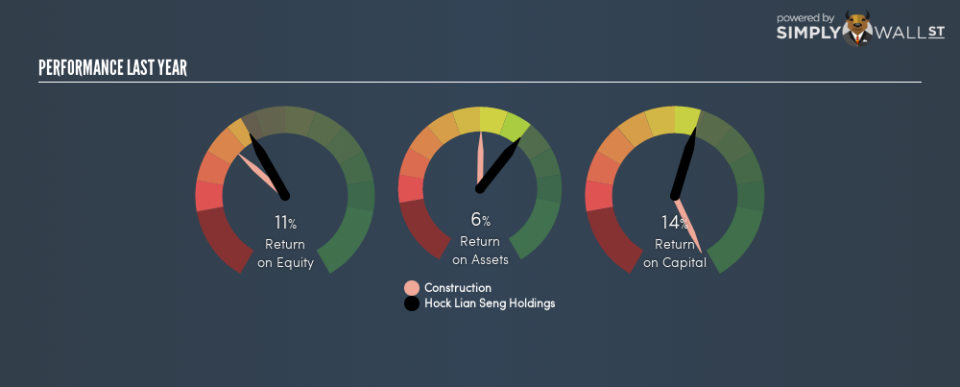Is Hock Lian Seng Holdings Limited’s (SGX:J2T) 11.3% ROE Strong Compared To Its Industry?

This analysis is intended to introduce important early concepts to people who are starting to invest and want to learn about Return on Equity using a real-life example.
Hock Lian Seng Holdings Limited (SGX:J2T) outperformed the Construction and Engineering industry on the basis of its ROE – producing a higher 11.3% relative to the peer average of 8.3% over the past 12 months. While the impressive ratio tells us that J2T has made significant profits from little equity capital, ROE doesn’t tell us if J2T has borrowed debt to make this happen. We’ll take a closer look today at factors like financial leverage to determine whether J2T’s ROE is actually sustainable.
Check out our latest analysis for Hock Lian Seng Holdings
Peeling the layers of ROE – trisecting a company’s profitability
Firstly, Return on Equity, or ROE, is simply the percentage of last years’ earning against the book value of shareholders’ equity. It essentially shows how much the company can generate in earnings given the amount of equity it has raised. While a higher ROE is preferred in most cases, there are several other factors we should consider before drawing any conclusions.
Return on Equity = Net Profit ÷ Shareholders Equity
ROE is measured against cost of equity in order to determine the efficiency of Hock Lian Seng Holdings’s equity capital deployed. Its cost of equity is 8.5%. Since Hock Lian Seng Holdings’s return covers its cost in excess of 2.7%, its use of equity capital is efficient and likely to be sustainable. Simply put, Hock Lian Seng Holdings pays less for its capital than what it generates in return. ROE can be dissected into three distinct ratios: net profit margin, asset turnover, and financial leverage. This is called the Dupont Formula:
Dupont Formula
ROE = profit margin × asset turnover × financial leverage
ROE = (annual net profit ÷ sales) × (sales ÷ assets) × (assets ÷ shareholders’ equity)
ROE = annual net profit ÷ shareholders’ equity
The first component is profit margin, which measures how much of sales is retained after the company pays for all its expenses. Asset turnover reveals how much revenue can be generated from Hock Lian Seng Holdings’s asset base. Finally, financial leverage will be our main focus today. It shows how much of assets are funded by equity and can show how sustainable the company’s capital structure is. Since financial leverage can artificially inflate ROE, we need to look at how much debt Hock Lian Seng Holdings currently has. Currently the debt-to-equity ratio stands at a low 7.3%, which means its above-average ROE is driven by its ability to grow its profit without a significant debt burden.
Next Steps:
While ROE is a relatively simple calculation, it can be broken down into different ratios, each telling a different story about the strengths and weaknesses of a company. Hock Lian Seng Holdings’s ROE is impressive relative to the industry average and also covers its cost of equity. ROE is not likely to be inflated by excessive debt funding, giving shareholders more conviction in the sustainability of high returns. ROE is a helpful signal, but it is definitely not sufficient on its own to make an investment decision.
For Hock Lian Seng Holdings, there are three fundamental factors you should further research:
Financial Health: Does it have a healthy balance sheet? Take a look at our free balance sheet analysis with six simple checks on key factors like leverage and risk.
Future Earnings: How does Hock Lian Seng Holdings’s growth rate compare to its peers and the wider market? Dig deeper into the analyst consensus number for the upcoming years by interacting with our free analyst growth expectation chart.
Other High-Growth Alternatives : Are there other high-growth stocks you could be holding instead of Hock Lian Seng Holdings? Explore our interactive list of stocks with large growth potential to get an idea of what else is out there you may be missing!
To help readers see past the short term volatility of the financial market, we aim to bring you a long-term focused research analysis purely driven by fundamental data. Note that our analysis does not factor in the latest price-sensitive company announcements.
The author is an independent contributor and at the time of publication had no position in the stocks mentioned. For errors that warrant correction please contact the editor at editorial-team@simplywallst.com.


